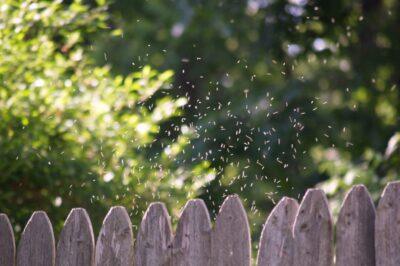
Image source: HomeFoodSafety
They say that good things come in small packages. Unfortunately, the same can be said for bad things. Some of the smallest creatures we encounter on a daily basis can cause some of the biggest annoyances, discomfort and even danger. I refer, of course, to biting, stinging and skin- burrowing insects.
In the best of times, a squadron of mosquitoes can wreck a pleasant evening on the front porch, ticks and chiggers can seriously detract from a pleasant walk in the woods, and gnats and no-see-ums can drive you crazy. More seriously, all these little biters can also be the vectors of disease.
The best cure for insect bites and stings, as for most ailments, is prevention. There are many products on the market today which deter insects, but as is so often the case they are generally laden with chemicals that are probably best not applied to the body. Your skin is your body’s largest organ, and a good rule of thumb is to not put anything on the outside that you wouldn’t want on the inside. Happily, plants and insects have been involved in a state of perpetual chemical and biological warfare since the dawn of time, and plants have developed a wide range of defensive measures. Many of these measures are contained in the essential oils which are derived from plants, and these oils can be used to great effect in your own personal battle with the insect realm, sparing you and your family from exposure to both bites and potentially harmful chemicals.
Two of the best insect deterring oils are lemon grass and citronella. These oils can be added to lamp oil or incorporated in homemade bees wax candles. Burning citronella or lemon grass lamps and or candles will drive off many flying insects such as mosquitos and gnats. They smell great, and can save an evening on the back porch. A few drops of the pure oils can also be applied to paper strips or cotton wool left out in rooms to prevent biters from mounting an indoor attack.
For a wide spectrum insect repellent, use the following formula:
- Four drops thyme oil
- Eight drops lemon grass oil
- Four drops lavender oil
- Four drops peppermint oil

Image source: IndianaPublicMedia
This mixture can be used in a number of ways.
- A few drops of the mixture can be diluted in alcohol to make a room or pillow spray that will keep insects at bay. This is very effective in preventing visits by the most annoying night raider, the mosquito.
- Put a few drops on ribbons or paper strips and hang near windows and doors to keep insects outside.
- You can make a body oil from it by diluting two drops of the mix in two tablespoons of carrier oil, such as olive oil or sweet almond oil. Apply the oil directly to the skin and massage it in, paying particular attention to exposed areas.
- For walks in the woods and other outdoor activities a splash or spray can be made by diluting five drops of the mixture in one tablespoon of witch hazel or two teaspoons of an alcohol such as vodka. Further dilute this in four tablespoons of distilled water. Put the resulting mixture in a small spray or misting bottle, and douse skin and clothing liberally before engaging in outdoor activities. In tick and chigger territory, give the tops of your socks and the bottom of your pants legs extra attention.
If your best preventative measures fail, and nothing is perfect, there are steps that should be taken as first aid for bites and stings. The first step is to thoroughly cleanse the affected areas. The formula for a topical disinfectant blend of essential oils is as follows:
- Ten drops lavender oil
- Twenty drops thyme oil
- Five drops eucalyptus oil
- Five drops oregano oil
Dilute eight drops of this mixture in a bowl of warm water and use this to wash and disinfect the site of a bite or sting. This is a topical antibiotic, and has many uses beyond just insect bites. You should keep some, or at least the ingredients, on hand at all times.
Story continues below video
For general insect stings, first carefully remove the stinger if it is present. This must be done with care, to avoid squeezing or rupturing the venom sack. After the stinger has been removed, apply one drop of straight lavender oil directly to the sting site every five minutes until 10 drops have been applied. A few more specific treatments are as follows:
- For bees and hornets remove the sting if needed, again being careful of the poison sack. Apply a compress of chamomile oil for as long as possible or needed. Follow up with one drop of straight chamomile oil three times a day for two days.
- For spider bites mix two drops of chamomile oil and three drops of lavender oil in a teaspoon of alcohol and apply to the area of the bite three times over the course of a day. Lavender oil has been reported to neutralize the venom of the Black Widow spider. If bitten, apply 10 drops of lavender oil directly to the bite every three minutes and seek medical care if available. Despite this spider’s bad reputation, bites are seldom life-threatening, but precautions should be taken.
- If you get a tick, do not pull it out. This can leave behind the head and increase the risks of infection. Use a drop of thyme oil to make it drop off. Once the Tick is gone a drop of pure Lavender applied to the site will stave off infection and reduce swelling and soreness.
Essential oils are, well, essential to a good holistic health care plan. They are also a very important item to stock, and gain knowledge about, in your self-reliance efforts. Properly used, the right blends of oils can repel biting insects and prevent many bites from occurring, reducing the associated risks of disease and infection. When bites do occur, the same oils can provide effective treatment. Essential oils confer many health benefits, and using them instead of commercially available products will insulate you from the risks of the modern chemical soups.
Are there other ways you use essential oils to chase away bugs? Tell us in the comments section below.
Sign up for Off The Grid News’ weekly email and stay informed about the issues important to you
 Off The Grid News Better Ideas For Off The Grid Living
Off The Grid News Better Ideas For Off The Grid Living




